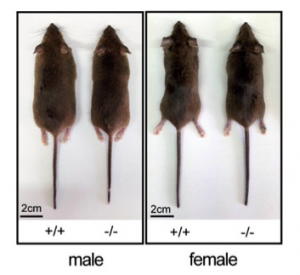By Lauriel Earley
You’ve probably already heard that you may have more bacterial cells than human cells in your body*, but did you know that you’re also part virus? About 5-8% of your genome is from viruses that integrated into the DNA of your ancestors. These pieces of virus that are in your genome are called ‘human endogenous retroviruses’ (HERVs) and are caused by ‘retrovirus’ infections. Retroviruses have an unusual viral life cycle because they must insert their genomes into the genome of a host cell in order to make more virus. When they do this, the inserted viral genome is called a ‘provirus,’ but if this viral DNA gets passed on to offspring from an infected sperm or egg cell, then the new DNA is called a HERV. Some examples of modern-day retroviruses are human immunodeficiency virus (HIV) and feline leukemia virus (FeLV).
“Junk” DNA isn’t always junk
When the integrated virus genomes get passed down from parents to their children (and are now called HERVs), they can accumulate mutations over time, so the viral genes can no longer produce functional proteins. These mutated sequences are usually considered part of the ‘junk DNA‘ in the human genome since they don’t have a discernable function, but we now know that some HERVs play important roles in development and disease. For example, a HERV gene called syncytin is important for the placenta to form during pregnancy. This protein was used by the retrovirus to fuse one infected cell with a neighboring cell and thus spread the infection, but now our bodies use it to help cells fuse during the growth of the placenta. Amazingly, the use of HERV proteins in development doesn’t just occur in humans! Versions of the syncytin gene from different retroviruses are in many different placental mammals, including mice.
Mighty mouse – a new function for syncytin

Mice with (+/+) and without (-/-) syncytin. The male mice without sycintin weigh18% less than those with sycytin. – Source
New research on syncytin found that this gene is also important for male mice to develop large muscles. Scientists in France noticed that when they deleted (‘knocked-out’) the syncytin gene in mice, the male mice weighed less, but the female mice didn’t change. Like humans, male mice have bigger muscles than female mice, so the scientists thought the loss in weight might be from a lack of muscle development. To test this, they measured the muscles from the mice that had syncytin and the mice that didn’t, along with a bunch of other body parts including the heart, kidneys, and bones. Only the muscles, not the other body parts, were smaller in the mice lacking syncytin. Cell-cell fusion is important for muscles to develop properly, and it turns out that removing syncytin impairs this process. The scientists also tested this in muscle cells from humans, sheep, and dogs. In all cases, the muscle cells with inhibited syncytin weren’t able to fuse normally, even though the syncytin genes in these species are from different retroviruses!
To sum up: millions of years ago, a retrovirus infected and integrated into the DNA of our mammalian ancestors, gave them a gene that allows cell to fuse together, and to this day modern mammals still use this gene in development.
There are still a lot of questions to ask, like why syncytin is only important for muscle development in males and not females, and exactly how much of an effect syncytin has in human muscle development (instead of human cells in a dish that have been used for studies thus far), but this is an exciting example of how viruses have played an important role in mammalian evolution.
*The original estimate of a 10:1 ratio of bacterial to human cells in a body was likely too high and it may be closer to 1:1, but we still don’t know for sure.
Further reading:
The Syncytin gene: Viruses Responsible for Human Life
Edited by Michelle Engle and Yitong Li
